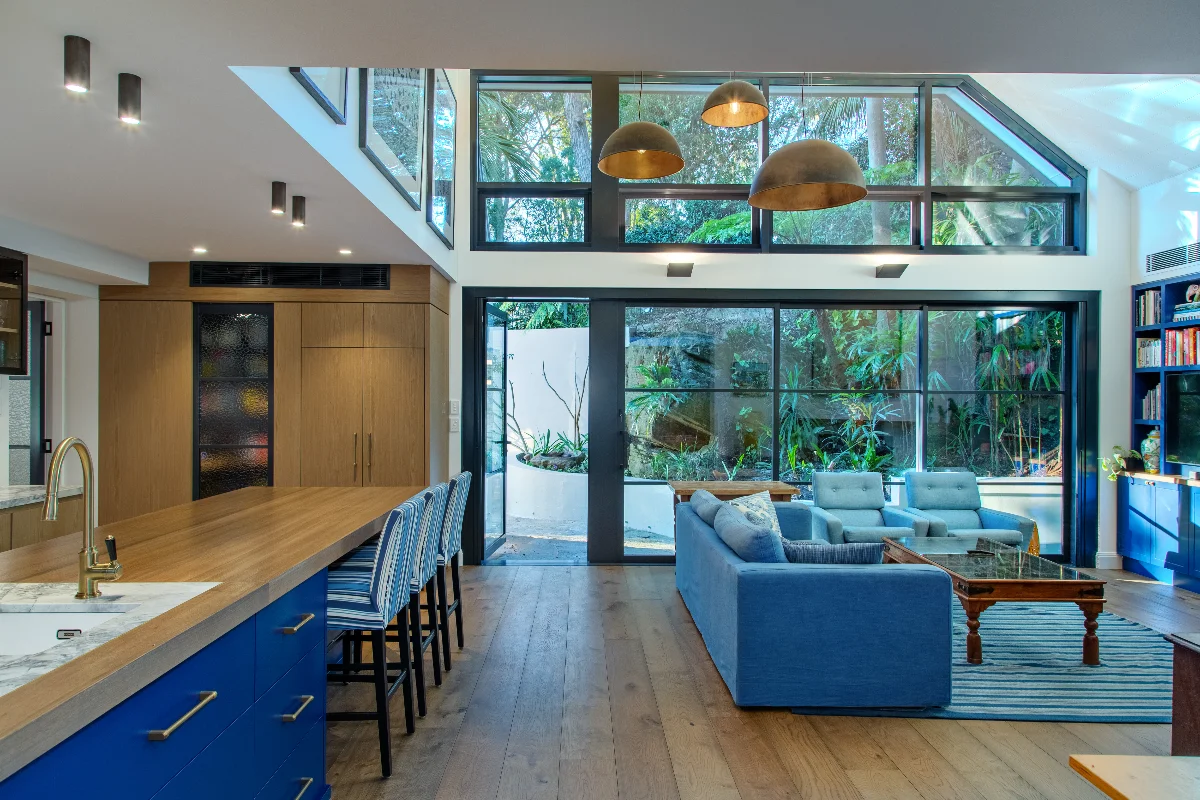Freshwater
Concept: Creating a light, airy, character-filled three-level Hampton-style beach home on a small corner site

Playoust Churcher Architects undertook a challenging yet highly rewarding renovation project of a Victorian-era cottage in McMahons Point, Sydney. The project presented a unique opportunity to marry the home’s heritage character with the modern demands of a family living space.
The original house, known as “Kinma,” was built in 1867 by Henry Mohrman. It has undergone several transformations over the years, including converting semi-detached homes into freestanding residences. Situated in the McMahons Point South Conservation Area, an area with deep historical significance, the renovation needed to respect the site’s heritage while addressing modern architectural challenges.

The project involved significant alterations and additions to the Victorian cottage to create a functional yet stylish home for a family with adult children. The brief outlined a need for relatively large bedrooms with en suites, multiple living areas, and a dedicated parents’ wing to provide a private retreat.
With the family’s shared passion for cooking, the kitchen and dining areas were essential hubs in the home and required special attention in the design process.
Balancing historical preservation with modern living needs was at the heart of this transformation. The site, bordered by apartment complexes, presented privacy issues for the occupants. The goal was to maximise natural light and stunning harbour views while ensuring the residents’ privacy and maintaining the views for the neighbouring homes.

The home’s heritage value, located in one of Sydney’s oldest districts, was key in shaping the renovation approach. The property sits in a highly sought-after area, with land originally granted to William Blue in 1817. Over the years, McMahons Point developed into a bustling suburb, and by the 1870s, the southern and middle sections were fully subdivided. Blues Point Road and the historical foreshores used for boatbuilding all contribute to the site’s rich history.
For the renovation, privacy and light were two key challenges. To address these, we designed a double-height space in the kitchen, meals, and family area. Extensive glazing was strategically placed to the east and north to flood the living spaces with natural light while maintaining a sense of seclusion from neighbouring apartments. This thoughtful use of glass brought a contemporary element into the design without compromising the historical feel of the home.
An additional design feature included the original well, which had served the property for over a century. Instead of covering or removing it, we incorporated it into the new design, transforming it into a unique feature within the meal room. We created a conversation piece that beautifully merges past and present by enclosing the well with a glass lid and extending the surrounding brickwork upwards to form a feature wall.

Given the house’s origins as two semi-detached homes, we used the layout to enhance the openness and connection between indoor and outdoor spaces. The kitchen, meals, and family rooms were oriented to create vistas in three different directions, linking the internal spaces with the external courtyards. These dual courtyards were extensively remodeled to accommodate use at different times of the day and throughout the year, providing flexibility and enhancing the home’s overall functionality.
Another critical consideration was the inclusion of the client’s personal aesthetic. The homeowner’s passion for colour played a central role in the design process, carefully collaborating with the client to ensure that the finishes and detailing aligned with their vision. By retaining and enhancing some of the original architectural details, the new work was seamlessly united with the old, honouring the home’s historical significance while introducing a fresh, contemporary feel.

The renovation’s outcome far exceeded expectations. Not only does the house now serve the practical needs of a modern family, but it also respects the historical importance of the McMahons Point South Conservation Area.
This project exemplifies the delicate balance between preserving the past and embracing the future. It shows how careful design can overcome challenges and create a living space that celebrates history and modernity. The home now stands as a testament to McMahons Point’s rich architectural heritage while offering the comfort and style of contemporary family living.

Playoust Churcher Architects has been the go-to architectural firm for the local community for well over three decades.
We specialise in residential heritage and contemporary renovations and new building developments. An integral part of your journey with us is our comprehensive process approach, tailored to meet the demands of our clients and council regulatory frameworks. Our team is well-positioned to maximise livability and financial return and is committed to delivering value that minimises risk and ensures projects stay on schedule and within budget.
We invite you to view our case studies and to contact our team for a comprehensive consultation on your project.
Victorian cottages are typically single‑storey homes from the late 19th to early 20th century with pitched roofs, lacework, decorative verandahs, and timber joinery. Renovation projects often aim to preserve these character elements while enhancing liveability with improved functionality, light, and layout.
Yes. Thoughtful design can retain key features like façade symmetry and verandah detailing while upgrading interiors with open-plan living, sunlit spaces, and modern finishes—achieving harmony between heritage charm and modern comfort.
Many Victorian cottages fall under local heritage or conservation overlays, which require council DA approval and a Heritage Impact Statement (HIS). These documents assess the design impact and demonstrate how the character is preserved or enhanced.
We combine technical expertise with heritage awareness: retaining architectural detailing, using appropriate materials, and extending layouts in ways that respect original scale and character. Our team manages consultant coordination, DA preparation, and thoughtful design delivery.
Absolutely. Our approach can integrate larger kitchen zones, updated bathrooms, improved thermal performance and indoor-outdoor extensions—without compromising the original façade, heritage proportion, or cottage identity.
It’s best to begin with a feasibility and site consultation. We assess zoning, heritage overlay, layout potential and design objectives, and help develop an intervention strategy—from concept sketches through to approvals and builder handover.

The cottage “Kinma,” dating back to 1867, lies within a deeply significant conservation area. The renovation demonstrates how heritage architecture can be sensitively adapted to serve modern family needs, blending historical character with refreshed functionality.

The brief called for large, en-suite bedrooms, multiple living zones, and a dedicated parents’ wing. These thoughtful additions showcase how design can elevate heritage homes to meet contemporary lifestyle demands.

Tackling privacy constraints surrounded by apartment buildings, the team introduced double-height living spaces and strategically placed glazing facing east and north. The result floods the interior with natural light while preserving seclusion and neighboring sightlines.

Rather than discarding historical elements, the original well was repurposed as a striking architectural feature in the dining area—capped in glass and framed by the brickwork—to merge historical narrative with contemporary interior design.
Managing Director & Nominated Architect
NSW Architect Registration No. 5924
With over 30 years of architectural experience, Brett Churcher leads Playoust Churcher Architects with a rare combination of design expertise and commercial insight. As a registered architect and Managing Director, Brett has played a pivotal role in delivering high-end single residential homes and boutique medium-density developments across Sydney’s North Shore and beyond.
Brett’s unique strength lies in his deep understanding of both architectural design and the Sydney property market. His valuation background enables him to align creative vision with practical feasibility, ensuring each project achieves both aesthetic excellence and financial viability.
At Playoust Churcher, Brett drives the studio’s growth, strategy, and leadership, while remaining closely connected to what matters most: the client. His ability to see the bigger picture from a client’s perspective and to guide projects seamlessly through the design process is at the heart of his role and reputation.

Reach out to Brett to explore how Playoust Churcher can bring it to life—with clarity, creativity and confidence.
Concept: Creating a light, airy, character-filled three-level Hampton-style beach home on a small corner site
Concept: Adapting a beautiful family heritage home in a quiet street on a large site to suit the family’s lifestyle
Concept: Designing a new family home that maximises the views and introduces a sense of open space
Concept: A complex yet successful renovation of this stunning heritage home in a conservation area
Concept: A 1970s build transformed into a bright, open design maximising stunning harbour views
Concept: A complete rebuild of half the property over two levels, whilst also incorporating the property next door
Concept: A majestic holiday home that pushes the design envelop, blending sustainable materials and natural light
Concept: A major ground floor renovation of a large estate with a new three-car garage and 14 metre pool
© Copyright Playoust Churcher 2025 All rights reserved. Website by Brilliant Digital.
We live and work on the lands of the Gadigal people of the Eora nation. We acknowledge their traditional custodianship of the land and pay respects to their Elders past, present and emerging.